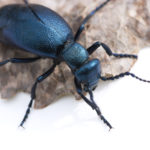
Beetle Pest Control and Extermination Services
Legacy Pest Control provides beetle extermination services in Wyoming. Some common types of beetles in Wyoming include Carpet Beetles, Warehouse Beetles, Blister Beetles, Weevils, and Wood Boring Beetles. Our beetle pest control experts are to answer any questions you may have, and to provide a free estimate over the phone.
Carpet and Warehouse Beetles
Several species of beetles tend to be grouped under these names because of their similarities. The easiest way to recognize them is by the yellow, white and brown patterns on their backs and wings. They’re capable of flight, but you’ll more often find them crawling.
Carpet and warehouse beetles get their common name from the things they tend to infest. Usually, any unsealed food will be found by these beetles. Once they get into the food, they’ll reproduce rapidly and the food is ruined. Keep in mind that this can be any dry goods. Pet food is a common source of the infestation.
The best way to prevent carpet and warehouse beetles is to keep your food sealed. If you do find them, dispose of the infested food in sealed bags far away from the house. Of course, you can also call the exterminator to make sure the job is handled from the start.
Blister Beetles
There are a few different types of blister beetles in Wyoming. They tend to be one inch or less in length, and they are often attracted to light. They’re known for eating plants, and they can devastate gardens and lawn vegetation. In fact, this is where you’re most likely to find them. They may occasionally wander inside to follow a light source, but they mostly prefer to be among plants.
Blister beetles get their name from their defense mechanism. When threatened, they secrete a fluid that can irritate the skin and cause blisters. It’s more of a nuisance than a source of harm, but it’s not entirely enjoyable to experience. More importantly, a buildup of this fluid can actually be harmful to plant-eating animals if the beetles infest food stores.
Weevils
Weevils are the largest group of beetles, encompassing more than 1,000 different species. They come in many shapes, sizes and colors, but they still tend to be small. Weevil infestations can get out of hand pretty fast. They typically sneak into the house inside of packaged foods or bulk products. Since the eggs are too small to see with the naked eye, it’s all too easy to bring something home that contains weevils.
The major problem is that they, like most beetles, can get into your food stores and ruin them. Once again, dried food is at the greatest risk. They are also known to kill house plants and susceptible garden plants. Fortunately, they tend to rank more as a pest than a danger.
Wood Boring Beetles
Adults of any species of wood-boring beetles are not harmful to wood. All the many species of wood-boring beetles lay their eggs in wood crevices or holes. It is only the emergent larvae that then damage and destroy wood. Wood-boring beetle larvae destroy furniture and undermine the structural integrity of homes and commercial buildings, devouring insides of wood beams and other objects for months and years unnoticed. The various species of wood-boring beetles have their own preferences of specific wood types.
Signs of wood-boring beetles can include wood powder from larvae eating through wood, leaving wood powder and excrement, a combination called frass. White powdery residue near wood structures can indicate a current beetle infestation. The yellow, clumpy powder may indicate that larvae have matured and relocated to reproduce. Their exit holes and tunnels are found bored into wood furniture, building structural beams, storage buildings, firewood, etc. The holes range from 1/8 to 1/2 inch in diameter, depending on the species.
Other means of wood-boring beetles identification include telltale signs of infestation, such as stains or blistering on wood surfaces caused by larvae tunneling just beneath the surface. Some species of wood-boring beetle may make a clicking noise as they eat wood.
A few common subspecies of wood-boring beetles include Powderpost Beetles, which grow to a maximum length of only about 1/4 as adults. They create holes of diameters up to about 1.6 mm. The dust they create does not contain pellets. Deathwatch Beetles reach lengths of about 1/8 inch. These beetles make a clicking sound while eating. Another subspecies is the Old House Borers, which grow from 1/2 to a full 1 inch in length. These beetles only eat softwoods, mostly preferring pine, and they bore dime-sized oval holes with frayed openings.
To prevent wood boring beetles from infesting your home, store firewood as far as possible away from your house. Keep wood dry, and inspect it for exit holes before buying. Although the destructive beetle larvae can be challenging to eliminate, because they live and eat inside the wood, agents containing borate penetrate wood, kill the beetle larvae, and then remain potent in the wood, helping prevent future infestations.
How Do You Get Rid of Beetles?
Since beetle infestations can make life uncomfortable, it’s important to have a method to treat the problem.
A four-tiered approach can eliminate beetles regardless of their classification:
-
- Inspect the problem to identify the type of beetle and full scope of infestation.
- Create a custom treatment plan that will eliminate the beetles.
- Educate in order to help prevent a return of the problem.
- Monitor to verify that the extermination was a complete success
Legacy Pest Control offers a free estimate for help getting rid of BEETLES.
Frequently Asked Questions on Beetle Pest Control in Wyoming
Contact our Wyoming Pest Control professionals to assess the extent of infestation and the safest and most effective beetles treatment.
